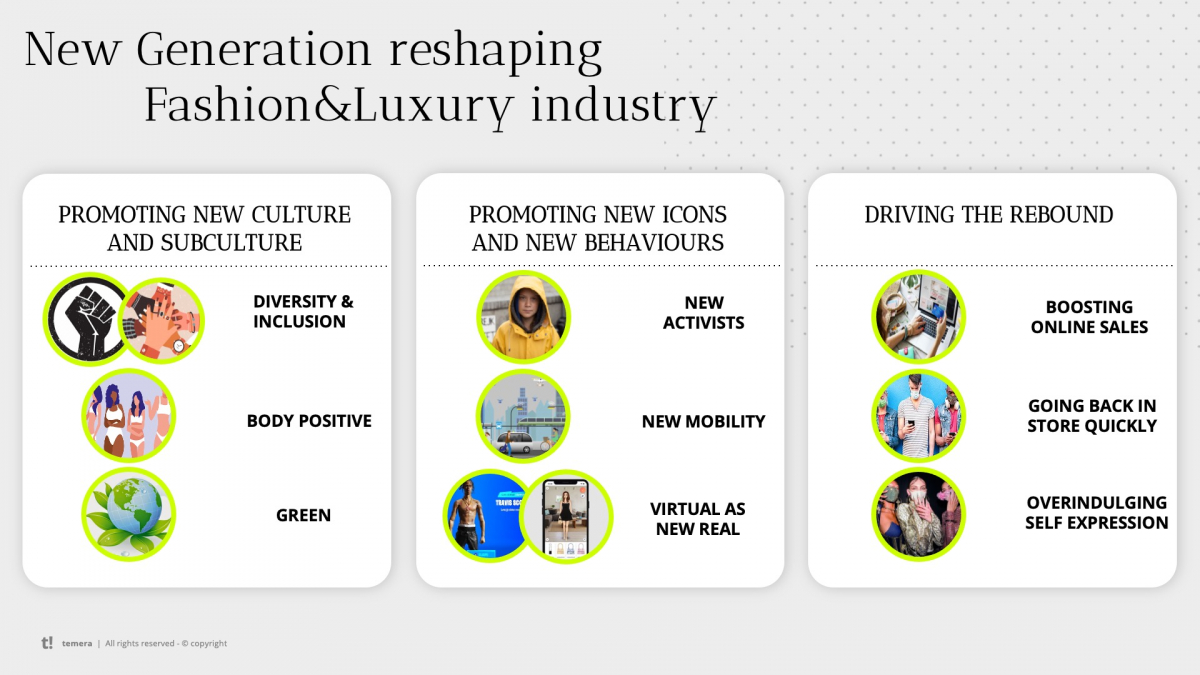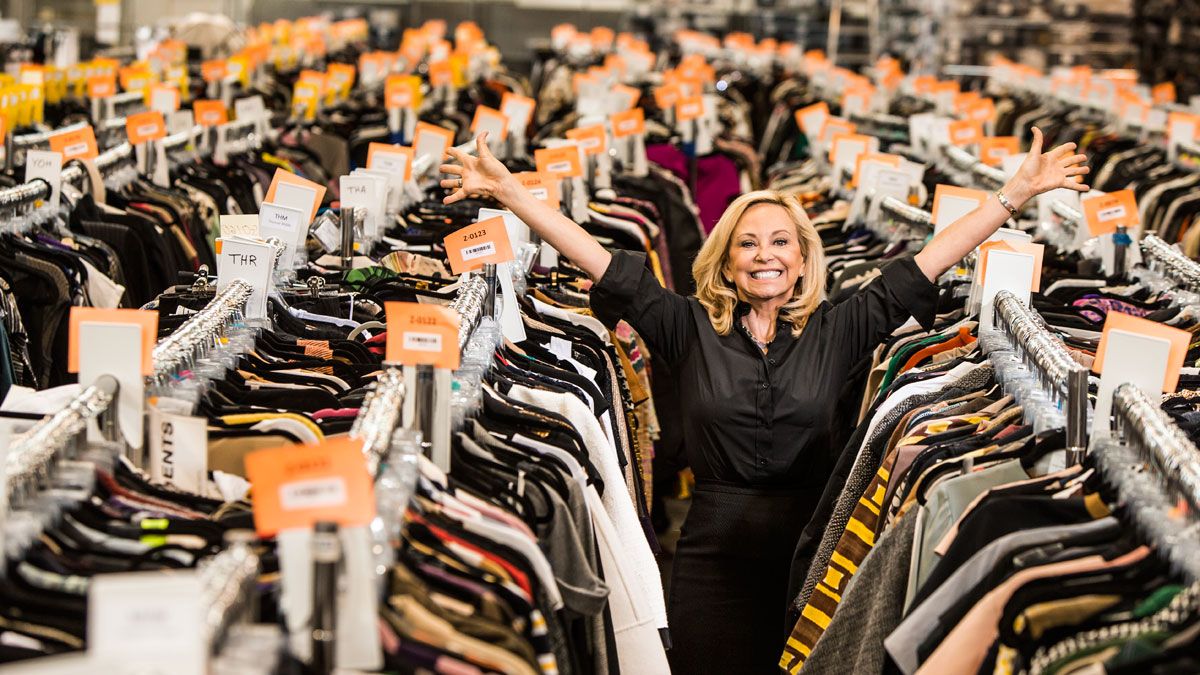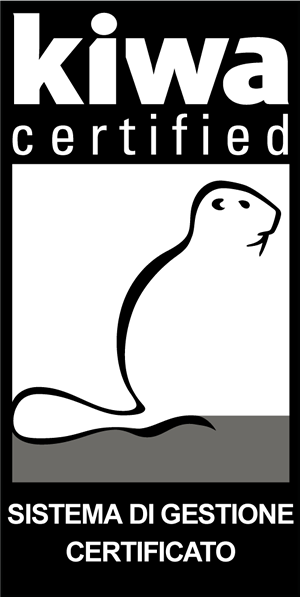ReCommerce platforms benefited the conjunction of continued economic downturn combined with the growing interest in sustainability.RealReal CEO Julie Wainwright in one of the warehouses of the company
ReCommerce
Second hand sales for clothing and accessories are booming. A phenomenon that could help solve the crisis of sustainability in the fashion industry.
Beside: storage units for jewelry in one of the stores of ‘The Real Real’
During 2020 we witnessed a “shift” that led Generation Z to emerge more and more through distinctive features and new habits, confirming its relevance as a great consumer of luxury.
The passing of the generational baton has helped to promote new cultures and subcultures, bringing to light the need for new aspirational models and new types of activism, which directly impact on consumption models.

Within this environment, a huge force is reshaping the luxury industry: second-hand clothing and accessories market.
According to a recent report, the value of the second hand market for just apparel is expected to grow in the United States over the next 10 years – from $ 28 billion in 2019 to $ 80+ billion in 2029 – and this within a market that is worth 379 billion dollars in total. In 2019, the second hand clothing market grew 21 times faster than retail sales in the same category.
Even more transformative is the potential that second hand clothing has to drastically alter the importance of fast fashion, a business model characterized by cheap and disposable clothing that emerged in the early 2000s, embodied by brands such as H&M and Zara. Fast fashion has grown exponentially over the next two decades, significantly altering the fashion landscape by producing more garments, distributing them faster, and encouraging consumers to shop in excess at low prices.
While fast fashion is expected to continue growing by 20% over the next 10 years, second hand clothing is set to grow by 185%.
As solution providers operating primarily in the fashion industry, curious observers of consumer habits and promoters of dynamics for sustainability, here at Temera believe that this trend in the second hand market has the potential to reshape the fashion industry and mitigate the harmful environmental impact of the industry on the planet.
The next big thing.
The second hand clothing market is made up of two main categories, thrift shops and recommerce platforms. It is the latter that has contributed to fueling the recent boom in a concrete way.
Used clothing has long been perceived as worn or contaminated, a naïve choice to wear research products or in some cases a prize for bargain hunters: sometimes the repurchase of exclusive or limited series products has even proved to be a harbinger of the creation of real treasures. This perception has progressively changed and many consumers now consider second-hand clothing to be of the same or even better quality than unworn clothing. Another trend has emerged with the name of “fashion flipping” : under this label underlies purchase of second hand clothes and subsequent resale, especially among very young consumer groups, less tied to the idea of “possession” and more inclined to the concept of “use” .
Thanks to the growing consumer demand and new digital platforms such as Tradesy, Poshmark, Depop or the Italian Armadio Verde, that facilitate the peer-to-peer exchange of daily clothing, the digital resale market is fast becoming the next big news in the fashion industry.
Generally speaking, the second hand market has become consistent for all luxury goods. Resellers such as The RealReal or Vestiaire Collective provide a digital marketplace for qualified ‘pre-owned’ luxury, where people buy and sell brands such as Louis Vuitton, Chanel and Hermès, to name a few. Without considering the recent direct agreement between The Real Real platform and Gucci label.
Furthermore, we cannot overlook the fact that the purchasing trend for second-hand clothing also seems to be driven by affordability, especially in this period, during the crisis that occurred as a result of the pandemic. Consumers have not only reduced their consumption of non-essential items such as clothing, they prefere to ‘invest’ money more on quality items rather than on cheap and disposable ones.

A ‘transparency empowered’ consumer.
On some occasion Fashion industry has been associated with reputation problems both from a social and environmental point of view. Some “scandals” have sparked consumer complaints, highlighting an unfair treatment of workers in the supply chain; on the other hand, there are many researches that show how pollution and waste generated by clothing production have reached an increasingly less sustainable weight for the planet.

Less than 1% of the materials used to make clothing is being recycled to create new products, an annual loss of 500 billion Euros of raw materials. The textile industry produces more carbon emissions than airlines and naval industries combined together, and around 20% of water pollution worldwide is the result of wastewater from fabric manufacturing and finishing.
Consumers have become ‘empowered‘ thanks to the awareness of the ecological impact led by apparel manufacturing; then they started increasingly asking brands to expand their commitment to sustainability. Buying second-hand clothing could provide consumers with a way to fend off the fast-fashion system.
Buying second hand garments increases the number of users of a product, extending its life – a practice that has been drastically reduced in the ‘Fast Fashion‘ era. Not surprisingly, worldwide, in the past 15 years, the average number of times a garment was worn before being trashed has decreased by 36%.
Luxury items, traded on the second-hand market, maintains its value over time, unlike fast fashion products, thanks to its peculiar iconic design and the intrinsic quality of manufacturing.
That’s he reason why buying a high quality second hand garment is theoretically an environmental victory. Although, as this is a recent phenomenon, there are also detractors who argue that the second-hand market can actually encourage excess consumption by expanding access to cheap luxury clothing.
A research held by Hapres® the Journal of Sustainability has outlined through interviews with consumers how a certain level of “distrust” towards ReCommerce still remains, linked to the need to qualify the authentic product compared to the fake.
Those platforms wishing to establish an active role to reorient consumer behavior should do so with more energy, possibly by implementing new features of their social extensions to drive peer-to-peer interaction and organization more meaningfully; for example, using these features to help users show their trustworthiness, beyond the standard review system, or to facilitate online chat about a product in question.
Temera can put in place plenty of solutions to support the emerging needs of this market. Luxury brands who already use NFC technology by embedding tags within their products are capable to convey integrity and trust in the authenticity of the purchased product. Furthermore, the use of Blockchain and digital wallets for luxury customers could give rise to the exchange (parallel to the sale of the physical product) of ‘digital twins‘ by transferring a certificate of ownership in all respects.
In conclusion, we are facing a mature trend, ready to feed a promising market both from an economic and environmental standpoints. The sociality of these platforms will be a crucial element in the progress of behavior towards more sustainable ends.
